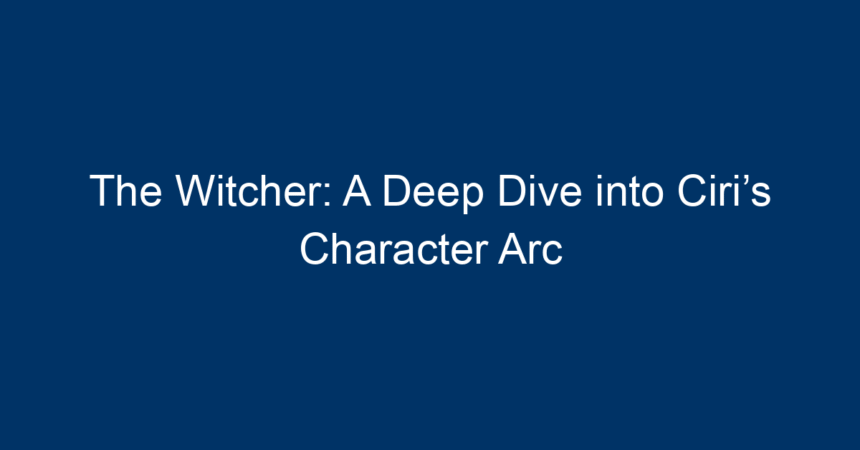In the sprawling universe of The Witcher, where magic, politics, and monstrous beasts intertwine, few characters are as compelling as Cirilla Fiona Elen Riannon, better known as Ciri. Initially introduced as the ward of Geralt of Rivia, her journey from a politically trapped princess to a formidable fighter is both captivating and complex. In this article, we’ll explore Ciri’s character arc in The Witcher, examining her growth, struggles, and the relationships that define her.
The Origin of Ciri’s Character
A Royal Bloodline
Ciri’s story begins in the midst of political intrigue and war. As the granddaughter of Queen Calanthe of Cintra, she embodies a royal heritage fraught with expectations. The dire circumstances following her kingdom’s fall during the invasion of the Nilfgaardian Empire push her into a life much different from that of a typical princess. This background lays the foundation for her challenges and the growth she will experience throughout the series.
Prophecy and Destiny
Integral to Ciri’s journey is the prophecy surrounding her. The line “The Lion Cub of Cintra” directly ties her fate to Geralt’s, establishing a bond that transcends mere coincidence. This intertwining destiny raises questions about autonomy vs. fate and sets the stage for her internal conflict, a recurring theme in The Witcher.
The Transformation of Ciri
From Innocence to Experience
In The Witcher, Ciri’s journey is marked by harrowing experiences that catalyze her transformation from a naive girl into a warrior. Early on, she is unaware of the world’s brutality, living a sheltered life. However, her encounter with monsters—both literal and metaphorical—forces her to confront her fears and adapt quickly. The death of her surrogate family and the loss of her home create a sense of urgency that shapes her personality.
Training at Kaer Morhen
One of the pivotal moments in Ciri’s character arc occurs when she arrives at Kaer Morhen, the home of Geralt and the other witchers. Here, she undergoes rigorous training, learning not just combat skills but also the values that come with being a witcher. The bond she forms with Geralt and the other witchers reflects the surrogate family theme prevalent in The Witcher. Their mentorship influences her mindset and equips her with the skills to navigate her tumultuous world.
The Complexity of Ciri’s Relationships
Ciri and Geralt: A Father-Daughter Dynamic
The relationship between Geralt and Ciri is central to the narrative. Their bond transcends bloodlines, with Geralt embodying a protective father figure. This relationship adds emotional depth to The Witcher series. Geralt’s teachings and protective instincts shape Ciri’s moral compass, highlighting themes of love and sacrifice.
Friendship with Yennefer
Ciri’s relationship with Yennefer of Vengerberg further complicates her character arc. Initially, Ciri sees Yennefer as a powerful figure, yet their dynamic evolves into a mentor-student bond. Yennefer’s influence pushes Ciri to embrace her magical abilities, although it also exposes her to the darker aspects of power. This duality illustrates the broader themes of light and darkness present in The Witcher.
Ciri’s Struggles with Identity
The Burden of Expectations
Ciri grapples with the heavy expectations placed upon her as the "Child of Surprise." The burdens of destiny weigh heavily on her, leading to significant internal conflict. The pressure to fulfill prophecies and live up to her family’s legacy causes her to question her identity. This theme resonates with audiences, reflecting the universal struggle of balancing personal desires and societal expectations.
Embracing Her Powers
As her story unfolds in The Witcher, Ciri begins to embrace her unique powers, including her ability to traverse different worlds through the use of her Elder Blood. Initially viewed as a curse, her abilities become a source of strength and independence. This transition signifies not only her acceptance of her identity but also her refusal to be a pawn in the grand game of fate.
Confronting Her Fears
The Monster Within
Ciri’s journey is as much about external challenges as it is about self-discovery. Throughout The Witcher, she battles not only physical foes but also her own inner demons. The trauma from her past manifests as PTSD, and her struggle to overcome this darkness adds layers to her character. The portrayal of mental health issues within a fantasy context provides a relatable aspect to her journey, making her characterization even more poignant.
The Fight for Independence
In the later parts of The Witcher, Ciri’s quest for independence becomes a significant focus. She confronts her fears head-on, learning to wield her power while accepting the chaos that comes with it. This progression signifies a shift from being a pawn to becoming a player in her own right in the intricate world of The Witcher.
Conclusion: Ciri’s Journey in The Witcher
Ciri’s character arc in The Witcher is a masterclass in storytelling. Her evolution from a frightened princess to a formidable warrior is marked by profound relationships, inner conflicts, and a quest for identity. The interplay of destiny, autonomy, and sacrifice enriches her narrative and resonates deeply with audiences.
Actionable Insights
- Embrace Transformation: Much like Ciri, allow yourself the space to grow, even through adversity.
- Value Relationships: Cherish the bonds that shape you. Mentors and friends can guide your journey toward self-discovery.
- Confront Your Fears: Ciri’s battles are both external and internal. Face your own challenges with courage; every struggle can lead to personal growth.
- Pursue Your Identity: Don’t let outside expectations define you. Forge your path and embrace your unique contributions to the world.
In the rich tapestry of The Witcher, Ciri stands out as a beacon of resilience, illustrating that true strength often arises not from the absence of fear, but in the courage to confront it. As fans continue to explore her journey, Ciri remains a symbol of empowerment, making her one of the most unforgettable characters in contemporary fantasy storytelling.




